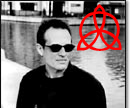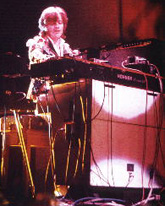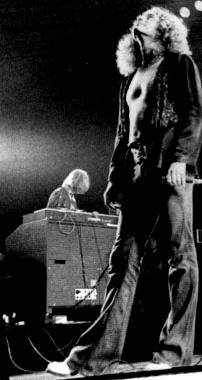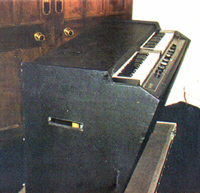

 |
|
JPJ and his Mellotron 400
(with a clavinet on top!) |
John Paul Jones' skills at arranging were put to great use for the studio tracks "Stairway To Heaven" and "The Rain Song." On "Stairway To Heaven," the song begins with four overdubbed recorders (wooden flutes) that add a beautiful chamber ensemble to Jimmy Page's single guitar intro. To recreate this arrangement live, a new instrument was introduced, beginning with the Japanese Tour of 1972. Later it would be used in the studio to create more memorable arrangements. This instrument -- the Mellotron -- would become one of the high (and low) points of Jones' work with Led Zeppelin.
The Mellotron was developed in England in the 1960s, and was based upon the Chamberlin, an American instrument. Both the Mellotron and Chamberlin operated on the same principle -- an organ-type keyboard would control many tape players underneath, giving the musician the opportunity to play taped "samples" of instrument sounds. Contrary to popular belief, the Mellotron does not have tape loops, but instead fixed lengths of tape (8 seconds long). When the tape reaches the end, it stops and rewinds to prepare to play the note again.
 |
|
JPJ at the Mk.V Mellotron (1977)
|
The first Mellotrons were called Mk.I's and soon were upgraded with new sounds to the Mk.II. These Mk.II's became famous instruments in the hands of the Beatles ("Strawberry Fields Forever") and the Moody Blues ("Nights In White Satin"). This type of Mk.II model was also used for Led Zeppelin's records. The Mk.II has two keyboards. The one on the right has instrument sounds, such as a flute, piano, mandolin, and saxophone. The left hand keyboard (rarely used on pop albums) was designed as a "rhythm section" with recorded ensembles playing in different styles such as jazz, foxtrot, waltz, etc.
Jones used the Mk.II for the beautiful string arrangements in "The Rain Song" from Houses of the Holy. The Mellotron violins are strangely haunting, and have limited fidelity. They are also difficult to play smoothly, as the sounds begin and end instantly. To overcome this, Jones used a volume pedal to swell the entrances and exits of the string lines to make them more realistic. In an interview specifically for this article, he describes his process for recording a simulated orchestra with a keyboard: "The secret of successful keyboard string parts is to play only the parts that a real string section would play. That is, one line for the First Violins, one line for Second Violins, one for Violas, one for Cellos, one for Basses. Some divided parts [two or more notes to a line] are allowed, but keep them to a minimum. Think melodically."
Many people consider "Kashmir" to be Led Zeppelin's greatest record. It's heavy Arabic flavor was incredibly unique, and very well executed. The blend of hard rock and orchestral instruments was perfect, and remains a classic example of a brilliant arrangement. Jones arranged "Kashmir" for both real strings and Mellotron strings. It is difficult for many to hear the difference between the "real" and simulated strings, which is a tribute to Jones' clever performance and arrangement. The Mellotron strings are most easily heard on the bridge, during the Gm and A chords.
 |
|
Jimmy Page's Mk.V
(photo courtesy Streetly Electronics) |
For the live concerts, Led Zeppelin used the Mellotron for the flute intro of "Stairway To Heaven," and the string of "The Rain Song" and "Kashmir." The model used for live work was an M400, a smaller white version of the old Mk.II design. The M400 was compact, but had fewer sounds. It was more reliable than the Mk.II model, but still prone to trouble. Jones explains, "To walk up to the Mellotron, not knowing if it was going to be in tune or what it was going to do, was a terrifying experience!" Indeed, many Mellotrons had badly designed motor control cards. This would cause the instrument to drift in pitch and sometimes fail.
For the 1977 tour, Jones played Jimmy Page's Mk.V Mellotron -- a rare protype of the Mk. V model that was actually two M400s in one unit. It was wide and black, and allowed twice as many sounds inside. Having two keyboards also allowed greater performance options since two sounds could be played simultaneously. Unfortunately, the Mk.V was no more reliable than the M400, and it was replaced with synthesized strings on the 1979 tour.